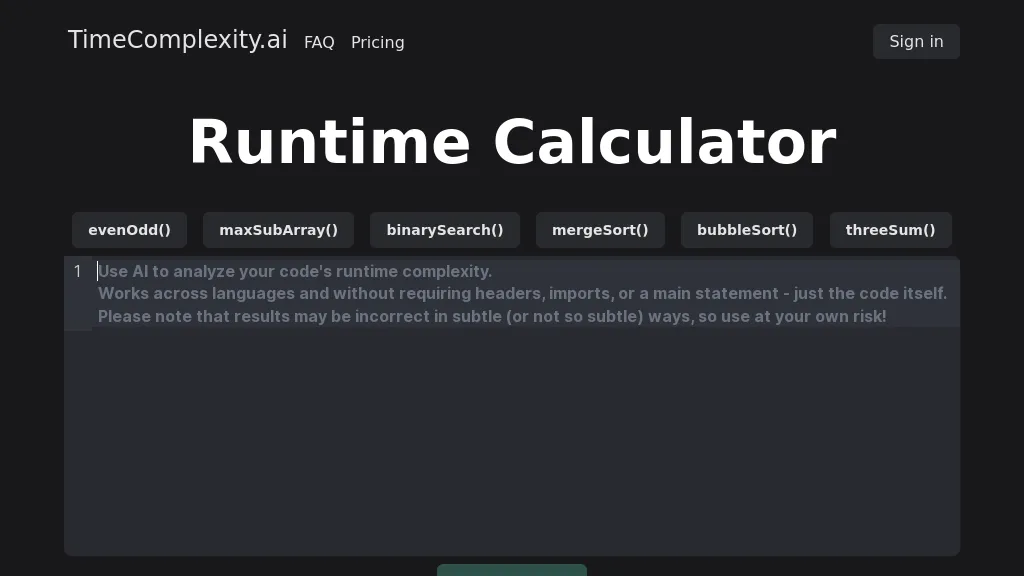What is Timecomplexity?
Timecomplexity is one such highly sophisticated AI-driven tool to gauge runtime complexity in the codes written across different dialects of programming languages. There are no headers, no imports, and even no main statement is required for the same. This provides a runtime calculator of various code pieces to understand the time complexity associated with that particular code.
Key Features & Benefits of Timecomplexity
It has a number of features and advantages which make this tool very important for a developer or any programmer in general. Some of the major features and uses of timecomplexity are described below:
-
Runtime Complexity Analysis:
Instant estimation of runtime complexity for small snippets of code. -
Optimize Algorithms:
Enhance the efficiency of algorithms by identification of inefficiencies in them. -
Bottleneck Detection:
Performance bottlenecks are identified automatically from your code. -
Compare Efficiency of Programming Solutions:
Compare different programming solutions for efficiency and make an informed decision on which to use.
This it does by using features such as time complexity, which enables developers to compact their code and thus achieve better efficiency in their applications.
Use Cases and Applications
It is versatile and thus can be utilized in a number of scenarios, as follows:
-
Algorithm Optimization:
Using Timecomplexity to tune algorithms for improved performance. -
Identifying Code Bottlenecks:
It helps to auto-detect code portions that cause the program to slow down or be inefficient. It helps in the examination of code for its overall efficiency and eliminates bottlenecks.
This tool can be of much advantage in the process of software development, education, and competitive programming. It is particularly useful for:
- Software developer—Optimization of code.
- Computer Science Students—Getting a better understanding of runtime complexity.
- Programming Enthusiasts and Competitive Programmers—Evaluation and improvement of solutions.
How to Use Timecomplexity
Using Timecomplexity is rather easy. Here is the step-by-step process:
- Paste the code snippet you would like to be analyzed in the tool interface.
- After doing so, hit the Analyze button.
- Finally, check time complexity results provided by the tool.
Apply insights and start optimizing and refining your code. For best results, your code snippet should be clean and clear. In such a situation, even beginners are amazed by how easy it is to navigate, and hence use the tool.
How Timecomplexity Works
Timecomplexity makes use of high-end AI algorithms in the analysis of bits of code. Here is a small overview of how this underlying technology works:
-
AI Algorithms:
It implements complex AI algorithms that make it understand and evaluate the code. -
Runtime Calculator:
A runtime calculator is used to see the time complexity for every snippet. -
Analysis Workflow:
The tool ingests the input code, runs the analysis, and gives a detailed result.
This blend of AI and runtime-based computation ensures correct and accurate complexity analysis for efficient optimization of code by the developer.
Pros and Cons of Timecomplexity
As any other tool, it has its share of pros and cons, which are stated below:
Pros:
- Correctness: It provides the correct time complexity for different snippets of code.
- Easy to use: It is user-friendly and readily understandable for both a beginner and an expert.
- Efficient: It pinpoints and solves performance bottlenecks.
Cons:
- Learning Curve: There is a learning curve for beginners to understand how to interpret the results.
- Language Support: Even though many languages are supported, really niche languages might not be covered.
In general, feedback from users has been related to the effectiveness of the tool in optimizing code and its ease of use, with minor grumblings regarding an initial learning curve.
Conclusion about Timecomplexity
Overall, time complexity is one of the most efficient tools in code analysis for its optimization. Its AI-driven approach provides accurate and enlightened complexity analysis, which, in itself, equates to a pricelessness of any value to any developer, student, or simply a lover of programming. Equipped with a user-friendly interface and a robust feature set, it must become a tool at one’s beck and call if a person wants to improve the performance of their code.
In the future, it will extend to more languages and capabilities with updates and enhancements, thus making it even more versatile and valuable.
Timecomplexity FAQs
-
Which programming languages does Timecomplexity support?
Timecomplexity supports a great variety of programming languages, thus versatile for various needs in coding. -
Is Timecomplexity free?
Yes, Timecomplexity has a free plan with basic features and limited usage. -
How accurate is time complexity analysis?
Timecomplexity applies advanced AI algorithms that supply very accurate time complexity analyses for different code snippets. -
Can Timecomplexity handle large codebases?
While it is optimized for smaller snippets, it can handle larger codebases, with some limitations depending on the plan you choose.










